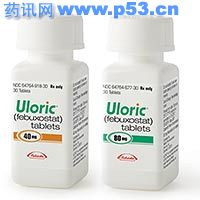痛风是由于晶体尿酸在关节沉积并引起炎症反应所致。治疗的目标是将血清尿酸水平降低到6mg/dL以下,目前的标准治疗药物是别嘌呤醇(allopurinol),属于黄嘌呤氧化酶抑制剂。
Febuxostat是一种非嘌呤类黄嘌呤氧化酶选择性抑制剂。APEX研究是第二项评Febuxostat临床疗效的关键性Ⅲ期临床试验。也是历史上规模最大的痛风试验。试验有1067名痛风病人或血尿酸水平≥8.0mg/dL的病人参加。病人在14天的洗刷期内首先开始痛风预防性治疗(秋水仙碱0.6mg/天或奈普生250 mg/每天2次,预防性治疗持续8-10周)。病人被随机分为5个组,分别为:Febuxostat 80mg/天(262人)、Febuxostat 120mg/天(269人)、Febuxostat 240mg/天(134人)、别嘌呤醇100-300mg/天(268人)和安慰剂组。治疗持续28周。首要的有效性终点是血尿酸水平降低到6mg/dL以下的患者比例。治疗开始时,患者的平均尿酸水平为9.85mg/dL,39%的病人尿酸水平超过10mg/dL。20%的病人在治疗开始时有痛风石。
试验结束前的最后3次月随访,和别嘌呤醇组相比,Febuxostat组有更高比例的患者血尿酸水平降低到6mg/dL以下。在28周时,和别嘌呤醇组相比,Febuxostat组也是有更高比例的患者血尿酸水平降低到6mg/dL以下。而别嘌呤醇在这两项指标上也优于安慰剂。尽管在试验开始时活性药物治疗组中需要接受治疗的痛风flare的发生率要高于安慰剂组,但到28周时,活性药物治疗组这一指标都要低于安慰剂组。在28周时,尿酸水平超过6mg/dL的患者痛风石的大小减小了40%,小于6mg/dL的患者痛风石的大小减小了50%。
|
|
最后3次随访 | 28周时 |
| 血尿酸水平降低到6mg/dL以下的患者比例(%) | ||
| 安慰剂组(134人) | 0 | 1 |
| 别嘌呤醇 100-300mg(268人) | 22* | 41* |
| Febuxostat 80mg(262人) | 48** | 76** |
| Febuxostat 120mg(262人) | 65*** | 87*** |
| Febuxostat 240mg(262人) | 69*** | 94*** |
| *p<0.05(和安慰剂相比) **p<0.05(和安慰剂、别嘌呤醇相比) *** p<0.05(和安慰剂、别嘌呤醇、Febuxostat 80mg相比) | ||
尽管34名病人发生了严重不良反应,但33名被认为和所研究的药物无关,有1名(Febuxostat 240mg组)出现了治疗相关的肾功能损害。9名病人因严重不良反应退出了试验。在有心血管疾病史的病人中,常见的严重不良反应都发生在心血管系统,5个组都有人发生。其他治疗相关的不良反应有肝功能异常、头痛、恶心和呕吐、腹痛、头晕。这些不良反应的发生率在各组间(包括安慰剂组)类似。在治疗开始时就有肾功能损伤的病人在治疗过程中不良反应的发生率并没有提高,包括那些Febuxostat 240mg组的病人。
FACT试验(Febuxostat与别嘌呤醇对照试验)是一项为期52周的临床试验。760名病人参加了试验。病人随机分为3组:Febuxostat 80mg组、Febuxostat 120mg组和别嘌呤醇 300mg组。156名病人有痛风结节,血尿酸水平≥8.0mg/dL。痛风结节的大小通过标准尺进行测量。在28和52周时,和别嘌呤醇组相比,Febuxostat 80mg组和120mg组的病人痛风结节减小得更显著。如果排除肘关节(因为容易与滑膜积液混淆),则组间的差异更为显著。此外,血尿酸水平小于6mg/dL的患者痛风结节的减小程度要大于超过6mg/dL的患者(分别为75%和49.7%)最常见的不良反应是腹泻、食欲不振、关节僵硬和关节痛。
| FACT试验中痛风结节大小的改变 | |||
|
|
别嘌呤醇组 | Febuxostat 80mg组 | Febuxostat 120mg组 |
| 和治疗开始时相比痛风结节在28周时的减小程度的中位值(%) | |||
| 所有痛风结节 | 28.6 | 29.5 | 49.5* |
| 排除肘关节的痛风结节 | 22.2 | 17.5 | 48.7 |
| 和治疗开始时相比痛风结节在28周时的减小程度的中位值(%) | |||
| 所有痛风结节 | 49.7 | 83.4 | 65.5 |
| 排除肘关节的痛风结节 | 28.7 | 87.0** | 72.5 |
| *p≤0.05(和别嘌呤醇、Febuxostat 80mg相比) ** p<0.05(和别嘌呤醇相比) | |||
Febuxostat由TAP制药公司开发,目前在美国通过FDA审批,在日本处于Ⅲ期临床试验阶段。适应症为痛风和高尿酸血症。
日本武田北美制药公司(Takeda)日前宣布 美国食品与药品监督管理局(FDA)已经批准其旗下新药非布索坦(febuxostat)用于治疗痛风病人的高尿酸血症,该新药为片剂,有两种剂型,分别是40mg和80mg,每日一次,口服给药。40多年以来,别嘌呤醇一直是临床上唯一一个用于抑制尿酸生成的药物,现在,全球数千万的痛风病人终于又有了一个新选择。非布索坦由日本东京Teijin制药公司研制,授权给武田公司在美国市场申请上市。
武田公司全球研究与发展中心主任南希.约瑟夫.里奇(Nancy Joseph-Ridge)博士说:“我们的新药给临床医生和痛风病人提供了一个新的选择,这个药物可以抑制尿酸的产生。很多痛风病人都没有意识到痛风是一种慢性疾病,需要长期治疗”。
目前医学界对痛风的治疗目标基本上是一致的,就是将患者血中的尿酸水平降到6mg/dl以下。非布索坦是一种黄嘌呤氧化酶抑制剂,而黄嘌呤氧化酶是体内嘌呤生成尿酸过程中的关键性酶。因此,非布索坦能有效地降低痛风病人体内的尿酸水平。该药已经通过多中心进
行的临床试验,总共有4000多人参加,其中一部分参与者的随访时间超过了5年。
其中规模最大,意义最重大的临床3期试验表明,非布索坦80mg的疗效优于非布索坦40mmg,别嘌呤醇300/200mg,在最后一次随访中,血尿酸水平降到6.0mg/dl的比例分别是67%,45%,42%。三者之间的差异有统计学意义。
对那些肝功能或者肾功能有低-中度损害的病人来说,服用非布索坦仍然很安全,并不需要调整剂量。临床试验中该药最常见的副作用就是恶心,关节痛,皮疹和肝功能损害。
武田北美制药公司总裁艾伦.麦肯奇兹(Alan Mackenzie)说:“我们很高兴给美国500万痛风病人提供了一个新选择,这是40年来的第一次。我们公司严格的按照科学精神进行临床试验,给患者提供了一种全新的药物。FDA的这次批准对我们公司来说具有里程碑似的意义”。
美国FDA批准40年来首个治疗痛风药物febuxostat(商品名:ULORIC)
2009年2月16日,美国FDA批准了近40年来的第1个用于治疗高尿酸症的痛风药物。其为武田制药北美公司(Takeda Pharmaceuticals North America)的非布索坦(febuxostatULORIC)。本品通过降低患者血液中的尿酸水平改善痛风患者的症状。此外,武田制药北美公司作为本品在美国市场中的独立开发商与销售商。
根据武田公司的一项声明:本品的结构与40年前开发的黄嘌呤氧化酶抑制剂药物完全不同,它是一种全新的高效的非嘌呤类黄嘌呤氧化酶选择性抑制剂。黄嘌呤氧化酶是促进尿酸生成的关键酶。本品可以降低高尿酸血症痛风患者血液中的尿酸水平,在临床研究中已经证明了本品的安全性和有效性,而且在中-重度肝肾功能不全的患者中也不需要进行剂量调整。
本品的服用剂量为每日1次,一次40 毫克或者80毫克,但是本品不推荐用于无高尿酸血症的痛风患者。
本品的原研厂家为日本的另一家公司--日本帝人制药(Teijin Pharma)。在帝人制药公司总裁最近的一份声明中,我们可以了解公司对本品采取的全球战略。他称,在本品获得FDA的许可之前,Ipsen公司的产品也获得了欧盟的上市许可。Ipsen 公司是帝人制药关于本品在欧盟的许可公司,而武田北美制药是本品在美国的许可公司。所以公司在全球已经取得的了里程碑式的战略意义。同时他还指出,在亚洲市场,帝人制药将采取自主开发或联合开发的形式。
痛风是一组异质性疾病,遗传性和(或)获得性引起的尿酸排泄减少和(或)嘌呤代谢障碍。临床特点:高尿酸血症,以及尿酸盐结晶,沉积所致的特征性急性关节炎、痛风石、间质性肾炎、严重者呈关节畸形及功能脏爱。常伴尿酸性尿路结石。假性痛风常常与痛风混淆,因为其症状非常的相似,然后,假性痛风是由于磷酸钙的代谢障碍引起,而不是尿酸代谢障碍引起。
根据美国国家关节肌肉骨骼疾病与皮肤病研究所(NIAMS)的研究数据表明,在美国有600万20岁及其以上的人群生平中有患痛风的经历。通常40-50岁的男性患者较为常见,而绝经前的女性患者少见。经历过器官移植的患者也容易患痛风。NIAMS指出下列药物会增加患痛风的风险(1)利尿剂:呋塞米(furosemide);氢氯噻(hydrochlorothiazide);美托拉宗(metolazone)(2)水杨酸类:如阿司匹林(aspirin)(3)烟酸(4)环孢菌素 (Cyclosporine Neoral),(5)左旋多巴 (Levodopa)。
通用名:非布索坦
英文名:Febuxostat
商品名:Adenuric®(Ipsen公司)
类 别:抗痛风药
适应症:用于治疗痛风的慢性高尿酸血证。
剂型:片剂
规格:80mg、120mg
一、药理作用特点
痛风的发生是由于体内产生尿酸过多及肾脏清除能力下降,尿酸体内蓄积,导致尿酸盐结晶在关节及各脏器沉积。因此,痛风的治疗通常采取的手段是:促进尿酸排泄和抑制尿酸生成,并采用适当措施改善相关症状。
体内尿酸的生成与嘌呤代谢有关,在嘌呤代谢的最后步骤中,次黄嘌呤在黄嘌呤氧化还原酶(XOR)的作用下生成黄嘌呤,再进一步生成尿酸,抑制该酶的活性可以有效的减少尿酸的生成。非布索坦为目前世界上最新研制的XOR抑制剂,其通过高度选择性地作用于该氧化酶,减少体内尿酸合成,降低尿酸浓度,从而有效治疗通风疾病。
30年来,别嘌呤醇是临床上唯一一个用于抑制尿酸生成的药物,并作为痛风的黄金治疗药物广泛用于临床,在抗痛风的治疗中取得了不俗的成绩。
与别嘌呤相比,非布索坦具有明显优势:
(1)别嘌呤醇只对还原型的XOR有抑制作用,而非布索坦对氧化型和还原型的XOR均有显著的抑制作用,因而其降低尿酸的作用更强大、持久;
(2)由于别嘌呤醇为嘌呤类似物,不可避免的造成涉及嘌呤及吡啶代谢其他酶活性的影响。因此别嘌呤醇治疗中,需要重复大剂量给药来维持较高的药物水平。由此也带来由于药物蓄积所致的严重甚至致命的不良反应。而非布索坦为非嘌呤类XOR抑制剂,因此具有更好的安全性。
二、临床评价
一项多中心、双盲、随机Ⅱ期临床研究评价了非布索坦的安全性和对痛风的疗效。总共有136名男性和17名女性痛风病人随机接受安慰剂或本品(40、80或120mg/d),4周后检测发现,本品各剂量组病人血清尿酸浓度较治疗前均显著降低,按剂量由低至高各组分别平均降低37%、44%和59%,而安慰剂组病人仅降低了2%;绝大多数病人坚持完成了试验,本品和安慰剂组不良反应发生率相近,并且这些不良反应大多轻微,具有自限性,常见的有腹泻、疼痛、背痛、头痛和关节痛。
一项Ⅲ期临床试验平行比较了本品(80和120mg/d)和别嘌醇(300mg/d)的疗效。对760名病人进行的为期1年的研究显示,与别嘌醇组相比,本品组中有更多的病人达到主要试验疗效指标-最后3个月均测得sUA浓度低于60mg/L(所有受试者均为痛风病人,且试验前sUA浓度均在80mg/L以上);在治疗52周后,本品未能显著减少痛风石面积(痛风石是痛风特有的尿酸盐结晶的聚集体),但在试验早期的高剂量组,该作用较明显;各治疗组中,sUA浓度达标(<60mg/L)的病人较少再突发痛风,且其痛风石面积有更明显的减少;各治疗组的不良反应及其发生率相似,不良反应包括肝功能异常、腹泻、头痛、关节相关征和症状及肌骨骼/结缔组织症状。
Uloric, generic name febuxostat, has been approved by the FDA for the chronic management of hyperuricemia in gout. Uloric is the first new treatment option for gout in over 40 years.
The FDA arthritis advisory committee has recommended the approval of Uloric for the treatment of gout. Uloric, the name that has been given to generic Febuxostat, was recommended by a 12-0 vote (one member of the committee abstained).
Febuxostat, a new treatment for gout, is at least twice as effective at lowering uric acid levels than allopurinol. Study results about febuxostat came from the largest and longest trial of gout drugs ever conducted.
Although gouty arthritis is not considered a difficult disease to diagnose and gout treatments are very effective in most cases, errors in the management of gout are common.
Gout is an intensely painful type of arthritis. There are 10 important facts you should know about gout.
Gout is one of the most painful types of arthritis. Gout is caused by uric acid crystals deposited in the body's tissues which lead to recurrent attacks of joint inflammation.
Gout is one of the most painful types of arthritis. Do you have symptoms which are associated with gout? Do you have a lifestyle which increases the risk factors associated with gout? Take our Gout Screening Quiz.
A risk factor increases your chances of developing gout but it is not certain that you will develop the disease.
Gout symptoms are very painful and are caused by monosodium urate crystals in joints and surrounding tissues. Gout symptoms can occur with more frequency if untreated.
How much do you know about gout? You probably heard of it, but do you know the difference between purines and gout medication probenecid? Do you know what you need to do to prevent gout attacks? Does your lifestyle put you at risk for gout? Take the Gout Quiz and test your knowledge.
Gout is one of the most painful types of arthritis. Gout attacks can be controlled or prevented by lifestyle changes and the use of certain medications.
We have designed our free newsletter e-course to guide you to better understand gout. Learn more about gout basics, gout history, gout cause, gout diagnosis, gout treatment, gout prevention, gout diet, gout medication, and gout research.


